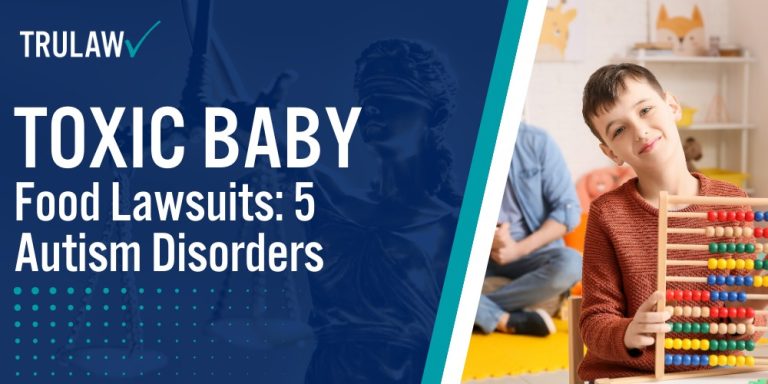The lawsuits allege that major baby food manufacturers knowingly sold products containing dangerously high levels of heavy metals, such as arsenic, lead, cadmium, and mercury.
Studies show that exposure to these neurotoxic metals, especially during critical stages of infant brain development, can significantly increase the risk of developing an autism spectrum disorder later in childhood.
The autism disorders most closely associated with toxic baby food in these lawsuits include:
- Autism and Asperger’s Syndrome: Classic autism and Asperger’s are the disorders most commonly claimed in toxic baby food lawsuits. Autism impairs communication and social interaction, while Asperger’s is a milder form on the spectrum.
- Pervasive Developmental Disorder (PDD-NOS): PDD-NOS includes cases that don’t fully meet the criteria for classic autism but have some autistic features.
- Heller’s Syndrome (Childhood Disintegrative Disorder): This rare, late-onset autism disorder involves a major regression in language, social, play, and motor skills starting between ages 2 and 10 after a period of normal development. Some lawsuits allege toxic baby foods triggered this dramatic decline.
- Kanner’s Syndrome (Autistic Disorder): Named after the psychiatrist who first described autism, Kanner’s syndrome refers to the most severe, “classic” form of autism. A few baby food lawsuits involve this level of impairment.
Autism Spectrum Disorder: Signs, Symptoms, and Severity Range
Autism Spectrum Disorder (ASD) encompasses a wide range of symptoms and severity levels.
Common signs include difficulties in communication, repetitive behaviors, and restricted interests.
Important symptoms to watch for may include:
- Avoidance of eye contact.
- Delayed speech development.
- Fixation of specific interests.
- Sensitivity to sensory input.
Severity can range from mild challenges to significant impairments in functioning.
Asperger’s Syndrome: High-Functioning Autism Characteristics
Asperger’s Syndrome is often referred to as high-functioning autism.
Individuals with this condition may have above-average intelligence but struggle with social interactions.
Key characteristics include, but are not limited to:
- Limited ability to understand social cues.
- Intense focus on specific interest areas.
- Preference for routines and sameness.
- Clumsiness or difficulty with coordination.
These individuals typically have strong language skills but may find it hard to engage in meaningful conversations.
Kanner’s Syndrome: Classic Autism and Its Unique Challenges
Kanner’s Syndrome, also known as Classic Autism, is marked by significant communication deficits and social isolation.
Unique challenges often include:
- Severe difficulties in verbal and non-verbal communication.
- Extreme sensitivity to sensory stimuli.
- Rigidity in routines and behaviors.
- Limited and repetitive play.
Interventions often need to be more intensive to address these substantial impairments and improve the quality of life.
Pervasive Developmental Disorder: Atypical Autism Presentations
Pervasive Developmental Disorder (PDD) describes atypical autism that doesn’t entirely fit other categories.
Atypical presentations may include:
- Inconsistent social interactions.
- Varied language development.
- Repetitive behaviors without significant intellectual deficits.
- Symptoms that appear later in development.
PDD requires personalized evaluation to determine appropriate therapeutic approaches.
Heller’s Syndrome: Rare Regressive Autism and Developmental Losses
Heller’s Syndrome, or Childhood Disintegrative Disorder (CDD), involves severe regression after years of normal development.
Developmental losses typically include:
- Sudden loss of language skills
- Withdrawal from social interactions
- Decline in motor skills
- Loss of bladder or bowel control
This rare disorder demands urgent and specialized interventions to manage and stabilize the regression.


